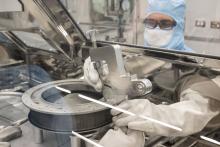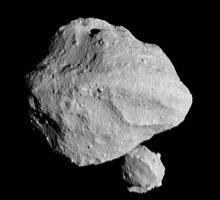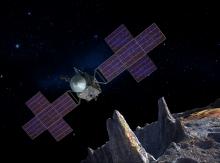You are here
Remnants from the Beginning
Yet many remained, and are still with us today: a small planet (and maybe more than one), icy planetesimals that orbit in the frozen realm beyond the planets, and giant boulders closer to the Sun, including some that cross Earth's orbit, presenting a potential threat to our planet.
All of these objects are important to astronomers because they help tell the full story of how the solar system formed and how it evolved. They also help scientists interpret their observations of other star systems, where big disks of material may be giving birth to planets.
Most of these leftovers orbit beyond Neptune, the most distant of the solar system's eight "major" planets. They formed from the disk of gas and dust that surrounded the newborn Sun. Small particles clumped together to form larger pieces, called planetesimals. These, in turn, merged to form the planets themselves.
After the planets were formed, their gravity hurled most of the remaining planetesimals into the Sun or into distant orbits around it. Billions of these icy leftovers orbit in the Kuiper Belt, which is just outside Neptune's orbit, or in the Oort Cloud, which is much more distant. Occasionally, the orbit of one of these bodies is disturbed and it falls toward the Sun, where it becomes a comet, with a long, glowing tail.
The other major group of leftovers is the asteroids. Millions of them orbit the Sun in a wide belt between the orbits of Mars and Jupiter. They probably were prevented from merging to form a planet by Jupiter's powerful gravity. The largest asteroid is about one-quarter the size of the Moon.
Many other asteroids follow orbits that bring them into the realm of the inner planets, including several thousand large ones that cross Earth's orbit. If one of these objects hit Earth it could devastate life on our planet, so astronomers are trying to locate all of the potentially dangerous ones and plot their orbits.
Comets and asteroids also present potential resources for future generations as they expand into the solar system. Many asteroids are rich in iron and nickel, and also contain smaller quantities of other metals. Comets and many asteroids are good sources of water, too. (Some scientists believe that much of the water on Earth came from comets.)
Using resources from these objects could reduce the cost of exploring and colonizing the solar system, and present the ultimate case of recycling: reusing the leftovers from the birth of the solar system.
Exploration
When Comet Halley last passed through the inner solar system, in 1986, pairs of spacecraft from Japan and the Soviet Union cruised through its tail, studying the composition of the gas and dust released from the comet's surface. The star of the Halley campaign, though, was the European Giotto, which passed about 330 miles (540 km) from Halley's nucleus and transmitted the first close-up pictures of a comet. It found that Halley's surface is as dark as charcoal, and that it was releasing gas and dust from several "jets," where ice vaporized as it was warmed by the Sun.
Galileo is best known for its reconnaissance of Jupiter. As it transited the asteroid belt en route to Jupiter, though, it made the first close flybys of asteroids, passing within a few hundred miles of Gaspra and Ida. It discovered that Ida has a tiny moon, which later was named Dactyl. In 1994, Galileo provided the only direct look at the impacts of Comet Shoemaker-Levy 9 on Jupiter.
The most extensive study of any minor body to date was provided by NEAR-Shoemaker, which entered orbit around the asteroid Eros on February 14, 2000. It transmitted thousands of images of the asteroid plus extensive measurements of its shape, composition, and gravity. Although it was not designed as a lander, as its fuel neared an end, flight controllers maneuvered it to a gentle touchdown on the asteroid's surface on February 12, 2001 -- the first landing on any asteroid or comet. The craft's instruments transmitted data from the surface for several days.
In 2004 and 2005, three spacecraft upped the ante in the exploration of the solar system's minor bodies. Stardust flew through the coma of Comet Wild 2, gathering grains of comet dust that it returned to Earth in early 2006. Deep Impact fired a probe at Comet Tempel 1, gouging a fresh crater and giving astronomers a look at material beneath the surface, which probably had remained unchanged since the comet's birth. And Japan's Hayabusa orbited asteroid Itokawa, landed on its surface, and attempted to gather a tiny sample of material for return to Earth in 2010.






